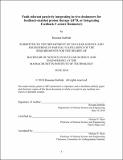Fault-tolerant passively integrating in-vivo dosimeters for feedback-enabled proton therapy (IF²D, or integrating feedback F-center dosimeter)
Author(s)
Iturbide, Rossana
DownloadFull printable version (3.641Mb)
Other Contributors
Massachusetts Institute of Technology. Department of Nuclear Science and Engineering.
Advisor
Michael P. Short.
Terms of use
Metadata
Show full item recordAbstract
Current dosimeters used in radiotherapy for cancer treatment fail to distinguish between radiation received by the targeted tumor and the surrounding healthy tissue. The Integrating Feedback F-center Dosimeter is designed to be fault-tolerant, with the capability to distinguish the radiation dose received between a targeted tumor and surrounding tissue. To provide a proof of concept of the IF²D, five alkali halide salts will be irradiated by a tandem electrostatic proton accelerator. These salts, (NaCl, NaI, NaBr, NaF, CsF), were chosen for their f-center properties which enable a direct conversion between the wavelength of the irradiated salt i.e. color change, and the expected radiation dose. We expect that analytical calculations between wavelength and expected radiation dose will correlate with experimental data. A direct conversion will enable the doctor to determine how much radiation the salt has received and therefore how much radiation dose the tumor itself has received. As a result, the patient will require less exposure time, and less radiation treatments, thus reducing the probability of obtaining secondary cancers. The following paper outlines the initial procedures taken to irradiate the selected salts and theoretical calculations that we expect to parallel future experimental data.
Description
Thesis: S.B., Massachusetts Institute of Technology, Department of Nuclear Science and Engineering, 2018. This electronic version was submitted by the student author. The certified thesis is available in the Institute Archives and Special Collections. Cataloged from student-submitted PDF version of thesis. Includes bibliographical references (pages 22-23).
Date issued
2018Department
Massachusetts Institute of Technology. Department of Nuclear Science and EngineeringPublisher
Massachusetts Institute of Technology
Keywords
Nuclear Science and Engineering.